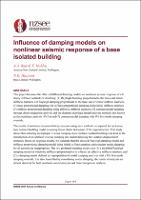| dc.contributor.author | Rad, Ali | |
| dc.contributor.author | Hazaveh, Nikoo | |
| dc.contributor.author | Holden, Tony | |
| dc.date.accessioned | 2021-06-22T04:01:59Z | |
| dc.date.available | 2021-06-22T04:01:59Z | |
| dc.date.issued | 2021-04-14 | |
| dc.identifier.uri | https://repo.nzsee.org.nz/xmlui/handle/nzsee/2394 | |
| dc.description.abstract | This paper discusses the effect of different damping models on nonlinear seismic response of a 8 storey 2D base isolated (BI) building: (1) Rayleigh damping proportional to the mass and initial stiffness matrices, (2) Rayleigh damping proportional to the mass and effective stiffness matrices, (3) mass proportional damping, (4) stiffness proportional damping using initial stiffness matrices (5) stiffness proportional damping using effective stiffness matrices, (6) constant modal damping through direct integration analysis and the dynamic nonlinear modal analysis method (also known as fast nonlinear analysis (FNA)) and (7) constant modal damping with 0% first‐mode damping override.
The results of nonlinear response history analyses using each method is compared for an 8-story base isolated building model assuming linear elastic behaviour of the superstructure. This study shows that selecting an improper viscous damping model in base isolated buildings can lead to the introduction of an artificial viscous damping and underestimating the isolators displacement demands. Based on response results, we conclude that the classical Rayleigh damping model and stiffness proportional damping model using initial stiffness matrices and constant modal damping for all periods are inappropriate. The two preferred damping models are (1) a modified Rayleigh damping model in which the stiffness-proportional term is based on effective stiffness matrices; and (2) a damping matrix defined by superposition of modal damping matrices with a 0% first‐mode damping override. It is also found that by considering modal damping, the results of analysis are almost identical for both nonlinear modal analysis and direct integration analysis. | |
| dc.language.iso | en | |
| dc.publisher | New Zealand Society for Earthquake Engineering | |
| dc.relation.ispartofseries | 2021;0164 | |
| dc.subject | Advancements in structural and geotechnical design and assessment | |
| dc.title | Influence of damping models on nonlinear seismic response of a base isolated building | |
| dc.type | Article | |

